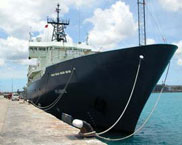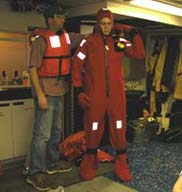|
|
|||||||||||||||||||||||||||||||||||||||||||||||||||||||||||||||||||||||||||||||||||||||||||||||||
 |
|||||||||||||||||||||||||||||||||||||||||||||||||||||||||||||||||||||||||||||||||||||||||||||||||
|
The Expedition Begins
The Lost City Expedition has begun! The R/V Atlantis departed Bridgetown, Barbados, at 1400 hours (2:00 PM) today. Barbados slowly became smaller and smaller as we gained distance away from the Caribbean island and sailed into deeper waters, heading northeast. Many of us stood on deck, watching the flying fish and taking a few last mental images of land.
We all worked to help each other tie down equipment in the labs and in the bow hold, which is used as a storage area for packing boxes and extra equipment. All of the tables in the lab have wood surfaces so they can be drilled into for securing instruments. In a matter of hours, an empty room on the ship is quickly converted into a working lab. Bungee cords, twine, different weights of line, as well as screws, scrap pieces of wood, and screw-eyes are all used to tie down and secure equipment. While the seas have so far been calm, there is always a chance we will hit bad weather, and in high seas one roll of the ship can send sampling equipment, test tubes, computers, and coffee mugs flying if they are not properly tied down. At 1600 hours we had a fire drill followed by an abandon ship drill. For fire drills, all of us gather in the main lab, wearing our life jackets and carrying a hat and our survival suit. While fires are not common on vessels, they can happen. They can be started by something in the engine room, a chemical spill, or even just a heater left on too close to a flammable material. Safety is the primary concern of everyone on board, and we work together to keep the work and living spaces safe, especially in such remote field sites.
At the end of the drills, we had a demonstration of donning a survival suit (or "Gumby suit"-named after the cartoon character). These suits are made of Neoprene and are designed to keep you warm for several hours to a couple of days in the water, depending on water temperature and weather. They can be challenging to put on because they are large and cumbersome! Most of us spent the evening working, reading, or watching movies. Tomorrow we have a science meeting at 0900. The seas remain calm! |
|||||||||||||||||||||||||||||||||||||||||||||||||||||||||||||||||||||||||||||||||||||||||||||||||


